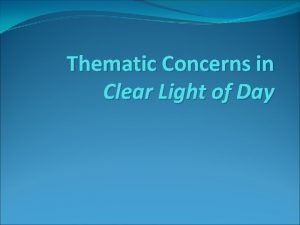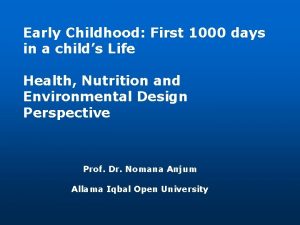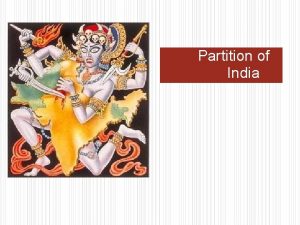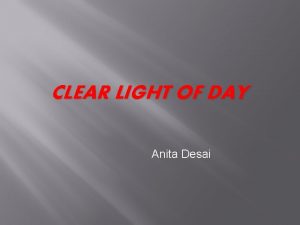Thematic Concerns in Clear Light of Day Partition







- Slides: 7

Thematic Concerns in Clear Light of Day

Partition The book is set at various times around the partition in Old Delhi. The tension between Muslims and Hindus are clearly shown by the father's refusal to allow Raja to go to a Muslim university and study Urdu literature because he has cause to fear for his safety. The book also mentions the partition riots as well as the refugee camps. It also depicts the flight of the Alis, the Das’s Muslim landlords and neighbors. These tensions often escalated into riots, but not in Old Delhi. The Hindus' claim to India led to the neglect, abuse and often violence towards Muslims in India or Hindus in Pakistan. The nation of India was torn apart in a violent manner, leaving refugees on both side of the border and mutual anger and hostility. The suspicious nature of the partition is also evidenced in the plainclothes police who felt Raja could be a Pakistani spy

Religion The religious undercurrents in the book manifest themselves in two ways: the partition (see above), and Raja’s relationship with the Alis. As a young adult he found acceptance (albeit not inclusion) in Hyder Ali’s nightly gatherings. His fascination with the Muslim culture, however, first manifests itself when he takes Urdu instead of Hindi, a language he considers banal, at school. Eventually he integrates himself into the Muslim culture and marries Hyder Ali's daughter, Benazir. However this relationship is strained during the partition and the Ali’s subsequent flight to Hyderabad.

Delhi �In the book, Old Delhi is frequently referred to as old, stagnant, or decaying. Old Delhi is overcrowded and generally overlooked in favor of New Delhi is considered vibrant, modern and alive. In the book New Delhi is where the characters, specifically Bakul, go to avoid the soporific effects of Old Delhi or even to be connected with the outside world. Bim is in New Delhi when she hears of Gandhi death, and Raja finds diversion and entertainment as a teenager in New Delhi

Separation The novel tells not just the story of the separation of a family, but also of a nation. The partition of India is a tangible reality that is concurrent to Raja leaving, Tara marrying, the deaths of the Das parents as well as Aunt Mira, and the separation of the Das family. These familial separations are parallel to the social events leading up to Partition and to the continued social upheaval that followed the separation of Pakistan from India. The summer of 1947 is described as tumultuous: it is the summer when Bim takes care of Raja in his illness, the Hyder Ali family abandons Delhi for Hyderabad under the threat of ethnic violence, and the father of the Das family dies. During the previous summer of 1946, the same summer that Jinnah made public demands for a Muslim homeland, the mother of the Das family had also died. The dissolution in the family that begins in 1946 parallels the growing Partition movement and the escalation of violence, such as the attacks in Calcutta in August 1946, in response to this division into two nations. In the summer of 1947, Tara marries Bakul and they leave for Ceylon (Sri Lanka), leaving Bim alone to care for the remaining family members: this coincides with the official division of India from Pakistan in August of that same year. The following summer, after the death of Gandhi earlier in January 1946 and the continued flight of refugees across Indian borders, Aunt Mira dies and Raja leaves for Hyderabad, thus isolating Bim further and leaving her to care for those who are left behind: Baba and herself. In particular, each of the three people who escaped (Tara, Raja and Aunt Mira) used a way of escape common during the Partition era: Tara fled the country for somewhere else, Raja fled to a Muslim center, and Aunt Mira left the earth entirely

Language �Each of the languages in Clear Light of Day represents different things. Urdu is the language of culture, refinement, and knowledge. Hindi is considered every day, mundane and banal. [12] Additionally the repeated examples of poetry emphasize the beauty of the one language compared to the other as more often than not they are in Urdu. Raja expounds how an Urdu poet could do that in a single couplet. Urdu symbolizes Raja and the Ali's culture and sophistication.

� Thank You













